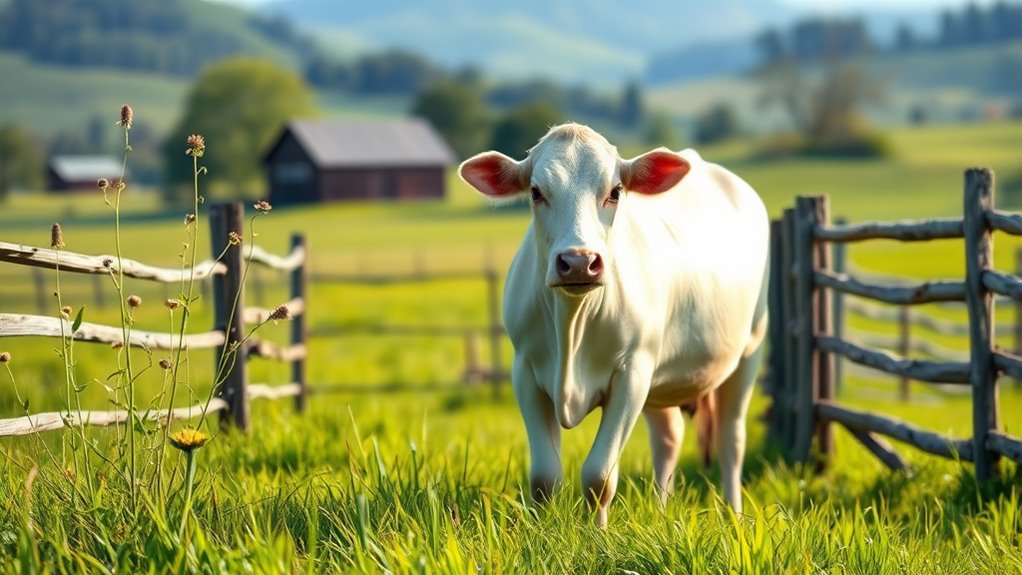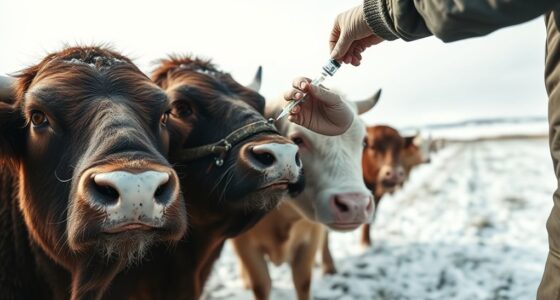To start with a family milk cow, focus on providing a balanced diet of quality forages, grains, minerals, and vitamins tailored to her age and stage. Prioritize herd health with regular checks, vaccinations, and a clean barn environment. Guarantee she has constant access to fresh water and a comfortable resting space. Keep detailed records of her care, and gradually introduce her to her new environment. To learn more about keeping your milk cow happy and healthy, continue exploring essential tips and practices.
Key Takeaways
- Choose a healthy, well-bred dairy cow suited for your farm size and environment.
- Provide a balanced diet with quality forage, grains, minerals, and vitamins tailored to her needs.
- Establish a regular health check, vaccination, and parasite control routine for herd health.
- Ensure access to clean water, comfortable shelter, and minimize stress for optimal milk production.
- Keep detailed records of feeding, health, and milk yield to monitor progress and make informed decisions.

Starting a family milk cow can be a rewarding way to provide fresh dairy for your household, but it requires careful planning and preparation. Before bringing a cow home, you need to understand the basics of dairy nutrition and herd health. These are essential to guarantee your cow remains healthy, productive, and happy. Proper dairy nutrition involves more than just providing hay; it means offering a balanced diet that meets all her nutritional needs. High-quality forages like hay or pasture should be the foundation, supplemented with grains, minerals, and vitamins tailored to her age, weight, and lactation stage. Consulting with a veterinarian or an agricultural extension agent can help you develop a feeding plan that promotes ideal milk production and overall health.
A balanced diet with quality forage and supplements is key to a healthy, productive family milk cow.
Herd health is equally critical. Regular health checks, vaccinations, and parasite control are your responsibilities as a caretaker. Keeping a close eye on your cow’s behavior, appetite, and physical condition can help you catch potential health issues early. For example, signs of mastitis—an infection of the udder—require prompt attention to prevent a dip in milk quality and yield. Maintaining a clean, dry living environment minimizes the risk of infections and disease. You should also establish a routine for hoof trimming and dental care, as these prevent pain and complications that could affect her ability to graze or produce milk effectively. Additionally, understanding the importance of proper dairy nutrition and herd health management can optimize her productivity and longevity. Implementing a regular monitoring system allows you to respond quickly to any health concerns that arise. Being aware of herd health protocols can also help prevent disease outbreaks that might jeopardize your entire herd.
Creating a feeding schedule and record-keeping system can further enhance her well-being and productivity, enabling you to make informed adjustments over time. Transitioning your cow into your farm environment should be gradual, giving her time to adapt. Provide a comfortable, dry shelter with ample space for resting and lying down; stress can negatively impact her milk production and immune system. Water is crucial—she needs access to fresh, clean water at all times to stay hydrated and maintain dairy productivity. Additionally, record-keeping is indispensable for tracking her health, breeding cycles, and milk yield, which helps you fine-tune her care over time.
Starting with a family milk cow is more than just acquiring an animal; it’s committing to her well-being through informed management. By focusing on dairy nutrition and herd health, you guarantee your cow remains healthy, productive, and a steady source of fresh milk. This proactive approach reduces the risk of illness, increases your success, and makes the experience more enjoyable. With proper care, your family cow can become a trusted part of your farm life, providing you with nourishing milk and a rewarding connection to sustainable living.
Frequently Asked Questions
How Much Space Does a Family Milk Cow Require?
A family milk cow needs enough space for comfortable pasture management and shelter. Generally, plan for about 1.5 to 2 acres per cow, depending on forage quality. Make certain you provide shelter that protects her from harsh weather and offers shade during hot days. Adequate space promotes healthy grazing, reduces stress, and keeps your cow happy and productive, making your farm more sustainable and enjoyable.
What Are the Best Breeds for Beginners?
When choosing a dairy breed for beginners, focus on beginner friendly breeds that are easy to handle and maintain. Popular options include Jersey, Guernsey, and Dexter, known for their friendly temperaments and manageable size. These breeds offer good milk production without requiring extensive care. Your goal is to select a dairy breed that fits your experience level and lifestyle, making the journey into dairy farming enjoyable and rewarding.
How Often Should I Milk My Cow?
You should milk your cow twice a day, typically morning and evening, to maintain a consistent milking schedule. This helps keep her comfortable and ensures steady milk production. After milking, store the milk in clean, covered containers to preserve its freshness. Regular milking and proper milk storage are vital for healthy cows and quality dairy. Stick to this routine, and you’ll have fresh milk whenever you need it.
What Are Common Health Issues to Watch For?
You should watch for common health issues like nutritional deficiencies and parasites. Keep an eye on your cow’s coat, appetite, and behavior for signs of deficiencies, such as dull hair or weight loss. Regular parasite management is essential—look for worms or diarrhea. Maintaining good pasture hygiene and providing a balanced diet help prevent issues. Catch problems early, and consult a vet if you notice anything unusual to keep your cow healthy.
How Do I Introduce a New Cow to My Herd?
When introducing a new cow, you should focus on cow socialization and herd dynamics. Start by keeping the new cow separated in a quiet area, allowing gentle introductions through a fence. Observe their interactions, guaranteeing they’re comfortable before full integration. Gradually increase their time together, watching for signs of dominance or stress. This slow process helps maintain herd harmony and ensures the new cow adapts smoothly into your existing herd.
Conclusion
Bringing a milk cow into your family is like planting a seed that grows into a steady, nourishing tree. With patience and care, you’ll find yourself reaping fresh, creamy rewards that make every morning feel like a warm sunrise. Remember, this journey is a dance of trust and effort—stick with it, and your farmstead will flourish with the sweet, simple joy of homegrown milk. Your new adventure is just beginning, so enjoy every drop of the ride.










